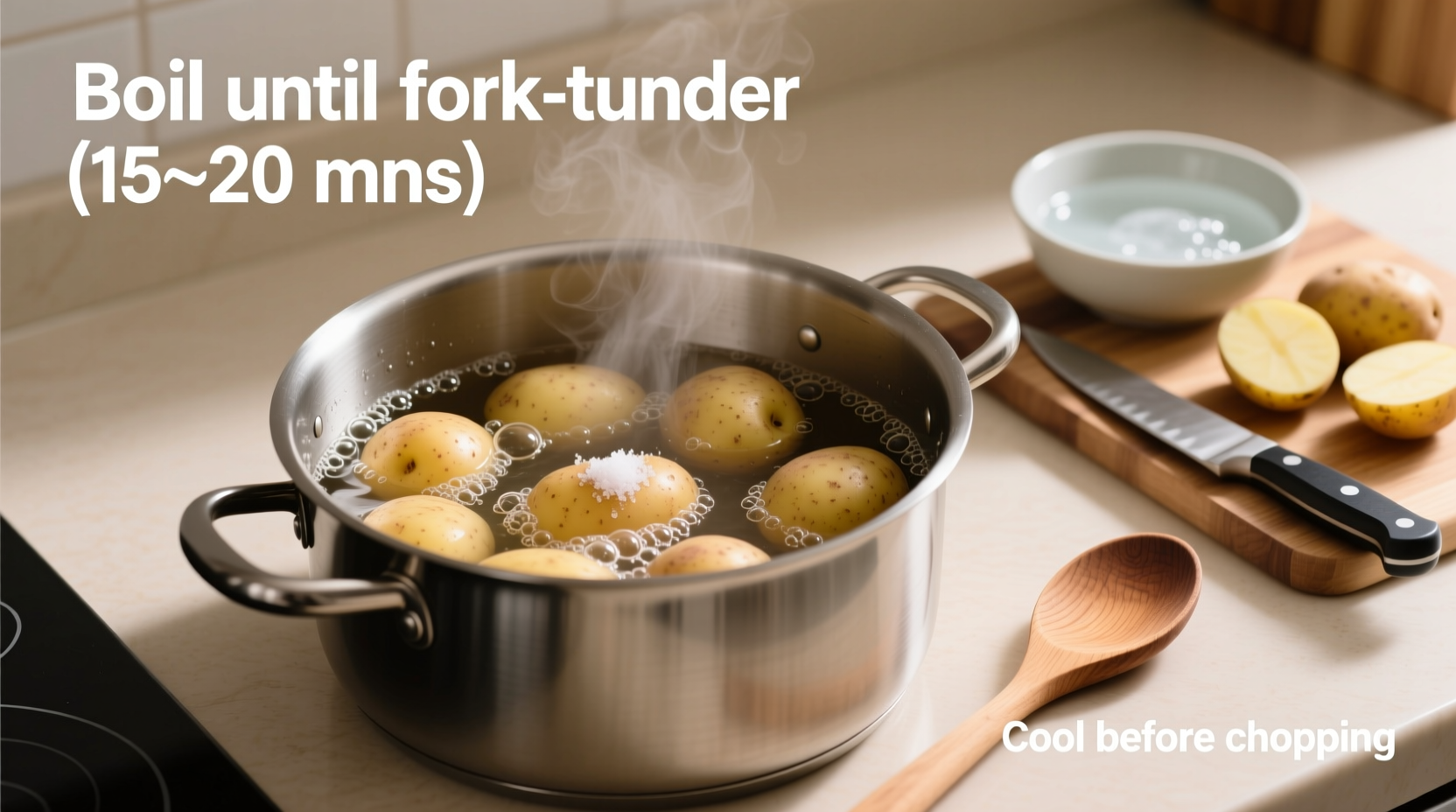The perfect boiled potatoes for potato salad start with waxy varieties like Yukon Gold or red potatoes, cut to uniform 1-inch cubes, simmered in salted water for 12-15 minutes until fork-tender but still holding shape, then cooled properly to prevent mushiness. This method ensures firm, flavorful potatoes that absorb dressing without falling apart.
Why Proper Potato Boiling Makes or Breaks Your Salad
Getting the boiling technique right is the single most important step in making exceptional potato salad. Unlike mashed potatoes where texture breakdown is desirable, potato salad requires potatoes that maintain their structure while absorbing dressing. Most home cooks make critical errors that lead to either undercooked chunks or a mushy, unappetizing mess.
Professional chefs consistently emphasize that potato variety selection and precise timing determine 80% of your potato salad's success. Overcooked potatoes release excess starch, creating a gluey texture that ruins the entire dish. Undercooked potatoes won't properly absorb the dressing flavors.
Selecting the Ideal Potatoes for Salad
Not all potatoes behave the same when boiled. The starch content dramatically affects how they hold up in salad:
| Potato Variety | Starch Content | Boiling Result | Best For Potato Salad? |
|---|---|---|---|
| Yukon Gold | Medium | Firm yet creamy texture | ★★★★★ (Top choice) |
| Red Potatoes | Low (waxy) | Holds shape exceptionally well | ★★★★☆ |
| Russet | High | Tends to fall apart | ★☆☆☆☆ |
| Fingerling | Low (waxy) | Maintains distinctive shape | ★★★★☆ |
According to agricultural research from the USDA Agricultural Research Service, waxy potatoes (like red varieties) contain 16-18% dry matter, while starchy potatoes (like Russets) contain 20-22%. This 4-6% difference significantly impacts how potatoes behave during boiling and cooling.
Step-by-Step Perfect Potato Boiling Method
Preparation: Setting Up for Success
Cutting technique matters more than most realize. Always cut potatoes to uniform 1-inch cubes before boiling. Uneven sizes lead to inconsistent cooking—some pieces become mushy while others remain undercooked.
Rinse cut potatoes under cold water until the water runs clear. This removes excess surface starch that would otherwise make your cooking water gluey and cause potatoes to stick together. Never skip this step when preparing potatoes specifically for salad.
The Boiling Process: Timing and Technique
Follow this precise method for consistently perfect results:
- Place potatoes in a large pot and cover with cold water by 1 inch (never start with hot water)
- Add 1½ tablespoons kosher salt per quart of water (this seasons from within)
- Bring to a gentle simmer over medium-high heat (not a rolling boil)
- Reduce heat to maintain a gentle simmer (small bubbles rising slowly)
- Cook for 12-15 minutes until a fork inserts with slight resistance
The National Center for Home Food Preservation confirms that maintaining a gentle simmer rather than a vigorous boil prevents the outer layers from overcooking before the centers are done. This temperature control is crucial for potato salad preparation.
Cooling: The Critical Step Most People Skip
Immediately after boiling, drain potatoes and spread them in a single layer on a baking sheet. Never cool potatoes in the cooking water or they'll continue cooking and become mushy.
For best results, let potatoes air-cool at room temperature for 15-20 minutes until just warm to the touch. Rushing this process by refrigerating hot potatoes creates condensation that makes them waterlogged. Proper cooling ensures potatoes will absorb dressing evenly without becoming soggy.

Avoid These 3 Common Potato Boiling Mistakes
Mistake #1: Starting with Hot Water
Putting potatoes directly into boiling water creates uneven cooking. The outside becomes mushy while the center remains hard. Always start with cold water to ensure even heat penetration.
Mistake #2: Overcooking by Just 2 Minutes
Timing is critical—potatoes go from perfect to mushy in as little as 90 seconds. Test one piece at 12 minutes; they should yield to a fork but still offer slight resistance. When making potato salad, slightly underdone is better than overdone.
Mistake #3: Adding Dressing to Hot Potatoes
Adding dressing while potatoes are still hot causes mayonnaise to break and creates a greasy texture. Wait until potatoes are just warm (not hot) before mixing with dressing for optimal flavor absorption.
Pro Tips for Next-Level Potato Salad
Season your boiling water properly: Use 1½ tablespoons kosher salt per quart of water. This isn't just for flavor—it helps the potatoes maintain their structure during cooking.
Add acid for firmness: Include 1 tablespoon of white vinegar or lemon juice per quart of water. The slight acidity helps set the potato's pectin, preventing breakdown during cooking.
Don't skip the resting period: Let dressed potato salad rest for at least 2 hours (preferably overnight) before serving. This allows flavors to meld and potatoes to fully absorb the dressing.
When This Method Works Best (and When to Adjust)
This boiling technique works perfectly for traditional American and German-style potato salads served cold. However, for warm French-style salade niçoise, reduce cooking time by 2-3 minutes to maintain a firmer texture that holds up to vinaigrette.
Altitude affects boiling times significantly. At elevations above 3,000 feet, increase cooking time by 25% as water boils at lower temperatures. The USDA Food Safety and Inspection Service recommends adding 5 minutes to cooking times for every 1,000 feet above sea level when preparing potatoes.











 浙公网安备
33010002000092号
浙公网安备
33010002000092号 浙B2-20120091-4
浙B2-20120091-4